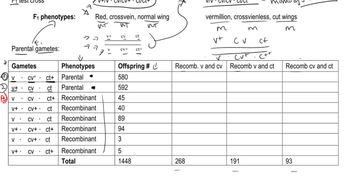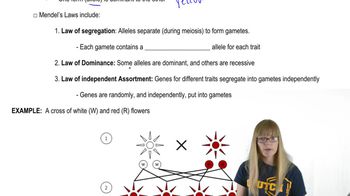Table of contents
- 1. Introduction to Genetics51m
- 2. Mendel's Laws of Inheritance3h 37m
- 3. Extensions to Mendelian Inheritance2h 41m
- 4. Genetic Mapping and Linkage2h 28m
- 5. Genetics of Bacteria and Viruses1h 21m
- 6. Chromosomal Variation1h 48m
- 7. DNA and Chromosome Structure56m
- 8. DNA Replication1h 10m
- 9. Mitosis and Meiosis1h 34m
- 10. Transcription1h 0m
- 11. Translation58m
- 12. Gene Regulation in Prokaryotes1h 19m
- 13. Gene Regulation in Eukaryotes44m
- 14. Genetic Control of Development44m
- 15. Genomes and Genomics1h 50m
- 16. Transposable Elements47m
- 17. Mutation, Repair, and Recombination1h 6m
- 18. Molecular Genetic Tools19m
- 19. Cancer Genetics29m
- 20. Quantitative Genetics1h 26m
- 21. Population Genetics50m
- 22. Evolutionary Genetics29m
2. Mendel's Laws of Inheritance
Mendel's Experiments and Laws
Problem 1d
Textbook Question
For parts (a), (b), and (c) of this problem, draw a diagram illustrating the alleles on homologous chromosomes for the genotypes given, assuming in each case that the genes reside on the chromosome in the order written. For parts (d) and (e), give the information requested.
progeny of the cross Rt/rT×rt/rt
 Verified step by step guidance
Verified step by step guidance1
<span>Step 1: Identify the alleles on homologous chromosomes for each parent in the cross Rt/rT × rt/rt. The first parent has alleles Rt and rT on its homologous chromosomes, while the second parent has alleles rt and rt.</span>
<span>Step 2: Draw a diagram for the first parent (Rt/rT). On one homologous chromosome, place the alleles R and t, and on the other homologous chromosome, place the alleles r and T.</span>
<span>Step 3: Draw a diagram for the second parent (rt/rt). Both homologous chromosomes will have the alleles r and t.</span>
<span>Step 4: Determine the possible gametes produced by each parent. The first parent (Rt/rT) can produce gametes with the combinations Rt and rT. The second parent (rt/rt) can only produce gametes with the combination rt.</span>
<span>Step 5: Use a Punnett square to determine the possible genotypes of the progeny by combining the gametes from each parent. Consider the combinations of Rt, rT, and rt to find the genotypes of the offspring.</span>
Recommended similar problem, with video answer:
 Verified Solution
Verified SolutionThis video solution was recommended by our tutors as helpful for the problem above
Video duration:
1mPlay a video:
Was this helpful?
Key Concepts
Here are the essential concepts you must grasp in order to answer the question correctly.
Homologous Chromosomes
Homologous chromosomes are pairs of chromosomes in a diploid organism that have the same structure and gene sequence but may carry different alleles. Each parent contributes one chromosome to the pair, resulting in genetic variation. Understanding the arrangement of alleles on these chromosomes is crucial for predicting inheritance patterns in genetic crosses.
Recommended video:
Guided course

Chromosome Structure
Alleles
Alleles are different versions of a gene that can exist at a specific locus on a chromosome. They can be dominant or recessive, influencing the phenotype of an organism. In the context of genetic crosses, identifying the alleles present in the parental genotypes helps determine the potential genotypes and phenotypes of the offspring.
Recommended video:
Guided course

New Alleles and Migration
Genetic Crosses
A genetic cross is a breeding experiment that involves the mating of two organisms to analyze the inheritance of specific traits. The resulting offspring, or progeny, can be predicted using Punnett squares or diagrams that illustrate the combinations of alleles from each parent. This method is essential for understanding how traits are passed from one generation to the next.
Recommended video:
Guided course

Trihybrid Cross

 8:06m
8:06mWatch next
Master Mendel's Experiments with a bite sized video explanation from Kylia Goodner
Start learningRelated Videos
Related Practice



